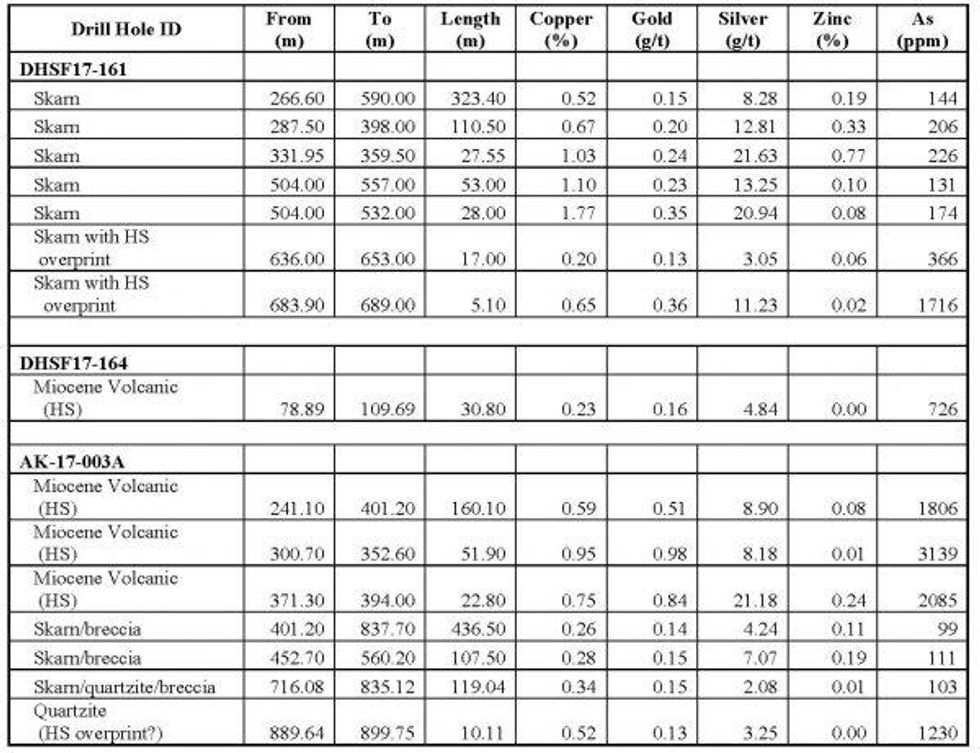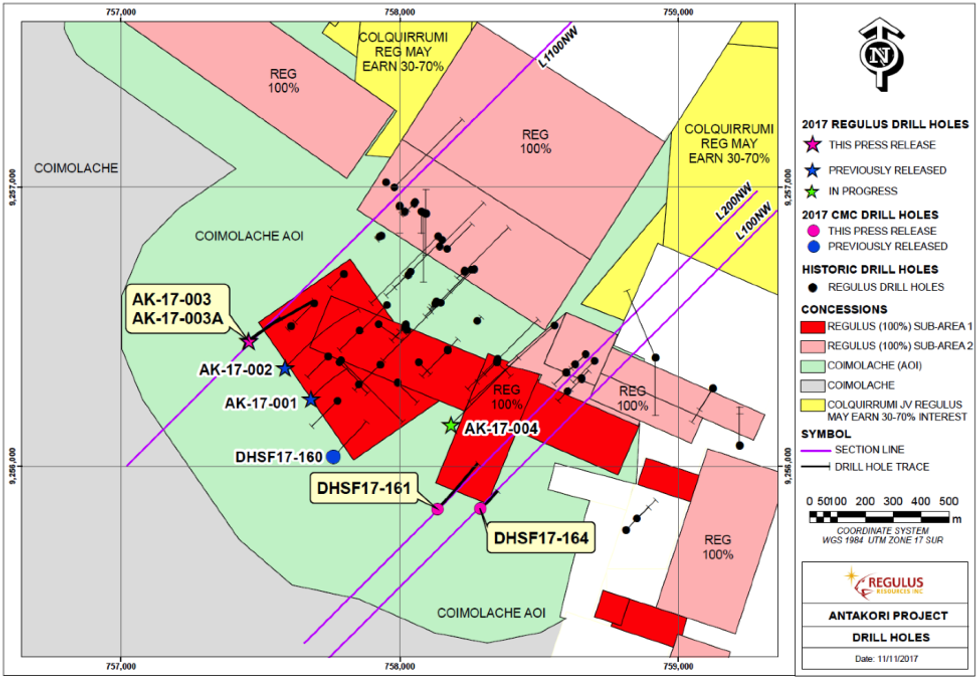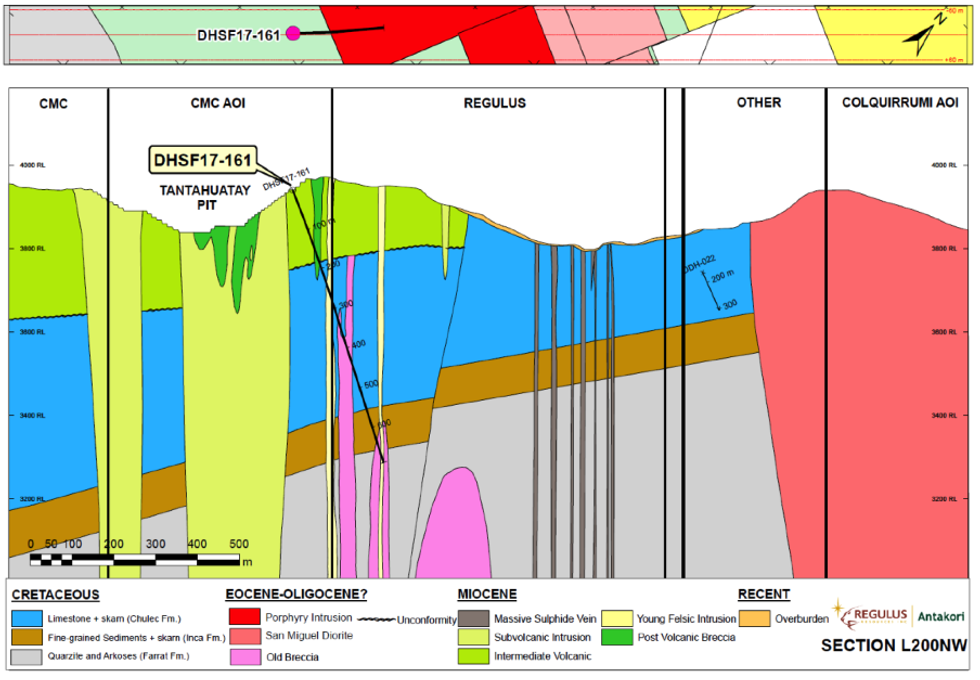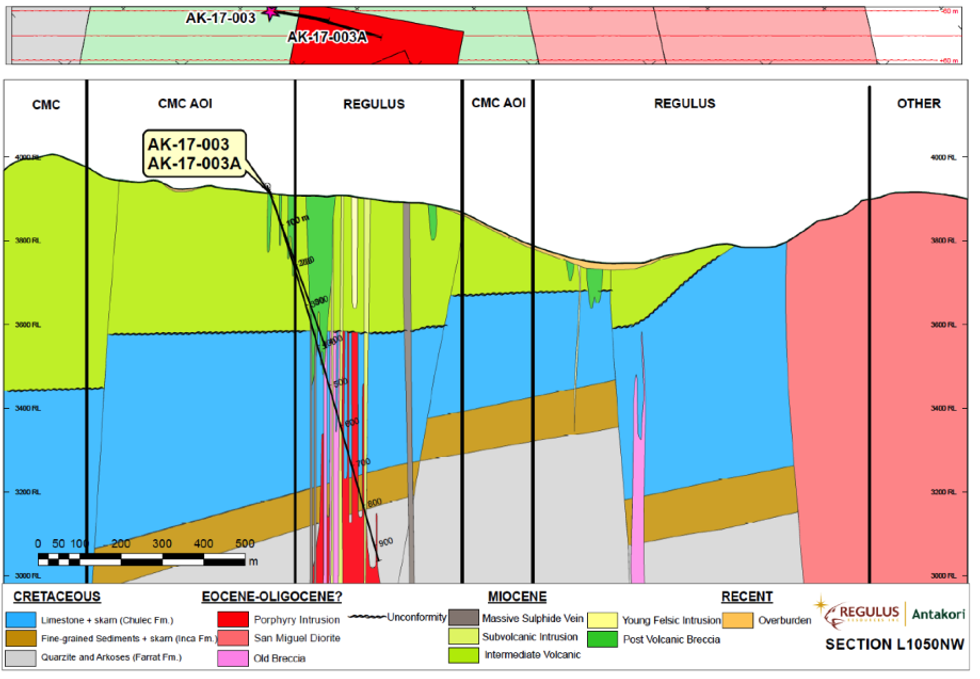Regulus Steps Out 400 Metres and Intersects 323.4 Metres With 0.52 Cu, 0.15 G/T Au and 8.28 G/T Ag at AntaKori, Peru
Regulus Resources Inc. (“Regulus” or the “Company”) (TSXV:REG) is pleased to announce the results from three additional drill holes at the Company’s AntaKori copper-gold-silver project in northern Peru. The drilling campaign is underway in collaboration with Compañía Minera Coimolache S.A. (“Coimolache” or “CMC”), the operator of the Tantahuatay gold mine, immediately to the south of …
Regulus Resources Inc. (“Regulus” or the “Company”) (TSXV:REG) is pleased to announce the results from three additional drill holes at the Company’s AntaKori copper-gold-silver project in northern Peru. The drilling campaign is underway in collaboration with Compañía Minera Coimolache S.A. (“Coimolache” or “CMC”), the operator of the Tantahuatay gold mine, immediately to the south of the AntaKori project (please refer to Regulus news releases of January 24, 2017 and April 5, 2017). Holes reported in this news release are AK-17-003A, drilled by Regulus and DHSF17-161 and DHSF17-164, drilled by Coimolache. The two companies are drilling simultaneously hence two numbering sequences for drill holes exist. Results are only reported herein for the portions of the drill holes that occur within Regulus concessions.
The AntaKori system hosts two principal styles of copper-gold-silver sulphide mineralization: 1) skarn and breccias within Cretaceous calcareous sedimentary rocks, likely associated with as-yet undiscovered porphyry mineralization; and 2) younger, epithermal high-sulphidation mineralization in overlying Miocene volcanic rocks and breccias that host the adjacent Tantahuatay heap-leach gold mine to the south. The younger high-sulphidation mineralization locally overprints the earlier skarn mineralization, particularly along the southern part of the AntaKori system. Drilling has commenced on the southernmost margin of the Regulus concessions and will proceed to the north over the next few months as permitting allows (see Figure 1). The initial holes will encounter the overlying Miocene volcanic rocks and high-sulphidation style mineralization prior to entering into the Cretaceous sedimentary sequence and skarn at depth. As the drilling progresses to the north, the volcanic rocks terminate and drill holes will commence directly in the skarn/porphyry environment within the Cretaceous sedimentary sequence.
AK-17-003A (938.1m) and DHSF17-161 (689m) were completed to targeted depths and cut both styles of mineralization, with well-developed skarn in the underlying Cretaceous calcareous sedimentary sequence. DHSF17-164 (303.8m) is a shallow hole that only crossed Regulus concessions for the interval from 78.9-109.7m depth within Miocene volcanic rocks. The more significant results from these three holes are listed below with additional details provided in Tables 1 and 2.
Highlights from drill holes AK-17-003A, DHSF17-161 – AntaKori Project:
- DHSF17-161: 323.4 m with 0.52% Cu, 0.15 g/t Au and 8.28 g/t Au from 266.6 m depth
- including 110.5 m with 0.67% Cu, 0.20 g/t Au and 11.81 g/t Ag
- including 27.55 m with 1.03 % Cu, 0.24 g/t Au and 21.63 g/t Ag
- including 53.00 m with 1.10% Cu, 0.23 g/t Au and 13.25 g/t Ag
- including 28.00 m with 1.77 % Cu, 0.35 g/t Au, 20.94 g/t Ag and 0.77% Zn
- All mineralization as skarn with relatively low As contents
- 400 m step out from any previous drilling on Regulus concessions
- including 110.5 m with 0.67% Cu, 0.20 g/t Au and 11.81 g/t Ag
- AK-17-003A: 596.6 m with 0.35% Cu, 0.24 g/t Au and 5.49 g/t Ag from 241.1 m depth
- including 144.7 m with 0.63% Cu, 0.57 g/t Au and 9.42 g/t Ag (HS mineralization)
- including 51.9 m with 0.95% Cu, 0.98 g/t Au and 8.18 g/t Ag
- including 107.5 m with 0.28% Cu, 0.15 g/t Au and 7.07 g/t Ag (skarn mineralization)
- including 119.0 m with 0.34% Cu, 0.15 g/t Au and 2.08 g/t Ag (skarn mineralization)
- including 144.7 m with 0.63% Cu, 0.57 g/t Au and 9.42 g/t Ag (HS mineralization)
These initial drill holes are located to the south and outside of the currently reported AntaKori NI 43-101 resource (see Southern Legacy news release of July 3, 2012; Wilson, 2012), which is very encouraging in terms of potentially adding additional tonnage to the AntaKori mineralized system.
John Black, Chief Executive Officer of Regulus, commented as follows: “We continue to be very encouraged with the results from drilling at the AntaKori project. Drill hole DHSF17-161 is particularly noteworthy in that it has encountered strong copper-gold skarn mineralization more than 400 m from any previous drilling in the Regulus concessions. The potential for a significant increase in resource tonnage in this direction is clear. We have now completed a series of five drill holes along the southern margin of our concessions, over a distance of approximately 900 m, with all holes encountering significant mineralization. Two additional drill rigs with greater depth capacity are now on site and will commence drilling this week. The arrival of the new rigs coincides with the approval of an extension to drilling permits which will allow us to advance to the north into the main part of mineralized skarn system as it is currently known. However, as we have learned with DHSF17-161, the full extent of this system is yet to be determined and we will be drilling continuously for the foreseeable future.”
Discussion of results and update on drilling program
The following table provides more detail regarding the mineralized intercepts encountered in drill holes DHSF17-161, DHSF17-164 and AK-17-003A. All three holes were drilled at a -70 degree angle to the northeast. The true widths of the mineralized intervals reported in Table 1 are difficult to ascertain and additional drilling will be required to constrain the geometry of the mineralized zones.
Table 1. AK-17-002 and DHSF17-160 results. Cu Eq and Au Eq values were calculated using copper, gold, silver and zinc (for intervals where zinc exceeds 1%). Metal prices utilized for the calculations are Cu – US$2.25/lb, Au – US$1,100/oz, Ag – US$14/oz, and Zn – US$1.00/lb. All intervals presented above consist of sulphide mineralization, with the exception of the narrow interval in DHSF17-164, which is partially oxidized. No adjustments were made for recovery as the project is an early stage exploration project and metallurgical data to allow for estimation of recoveries is not yet available. The formulas utilized to calculate equivalent values are Cu Eq (%) = Cu% + (Au g/t * 0.7150) + (Ag g/t * 0.0091) + (Zn % * 0.4444 (if Zn >1.0%)) and Au Eq (g/t) = Au g/t + (Cu% * 1.4026) + (Ag g/t * 0.0127) + (Zn% * 0.6234 (if Zn >1.0%)).
Table 2. DHSF17-161, DHSF17-164 and AK-17-003A results presented by lithology. HS = high sulphidation epithermal style mineralisation.
DHSF17-161 was drilled from the upper benches of the Tantahuatay pit along the southern margin of the Regulus concessions, about 400 m to the southeast of previously reported drill hole DHSF17-160, and was drilled at a -70 degree angle to the northeast (045 degree azimuth), crossing into Regulus ground at a depth of 266.60 m (see Figure 1 for location and Figure 2 for a simplified geologic cross section). The hole was within the Cretaceous sedimentary sequence with well-developed skarn mineralogy as it entered into Regulus concessions. Minor porphyry and breccia dikes cut the sedimentary rocks. The drill hole terminated in calcareous siltstones near the base of the Inca Formation, cross-cut by breccias and a late-stage felsic dike, without entering into the underlying Farrat Formation quartzite. Mineralization within the skarn sequence is pyrite-chalcopyrite-magnetite as disseminations, veinlets and massive replacements. Zinc is locally elevated, which may indicate that this is a more distal portion of the skarn system. The final 5.1 m of the drill hole averages 0.65% Cu, 0.36 g/t Au and 11.23 g/t Ag in breccia. This is the first drill hole in this portion of the Regulus property, with the nearest previous drill holes more than 400 m away.
Drill hole DHSF17-164 was drilled from the upper benches of the Tantahuatay pit along the southern margin of the Regulus concessions, about 400 m to the southeast of previously reported drill hole DHSF17-160, and was drilled at a -70 degree angle to the northeast (045 degree azimuth), crossing into Regulus ground at a depth of 266.60 m (see Figure 1 for location and Figure 2 for a simplified geologic cross section). The hole is mostly within the Coimolache concessions and only enters the Regulus concessions for the interval of 78.9-109.7 m depth (see Figure 1 for location). The narrow interval within Regulus concessions is within Miocene volcanic rocks that are pervasively affected by advanced argillic alteration with mineralization predominantly pyrite-enargite as disseminations, fracture coatings and locally as more massive veining with subsequent partial oxidation of the sulphide minerals.
Drill hole AK-17-003A was collared within the Coimolache concessions along the southern margin of the Regulus concessions, about 150 m to the northwest of previously reported drill hole AK-17-002, and drilled at a -70 degree angle to the northeast (055 degree azimuth) crossing into Regulus ground at a depth of 211.57 m (see Figure 1 for location and Figure 3 for a simplified geologic cross section). The initial attempt to drill this hole was lost at a depth of 411.4 m (AK-17-003) and was subsequently re-drilled from the surface as AK-17-003A which is reported here. The hole encountered Miocene volcanic rocks with strong high sulphidation alteration and mineralization to a depth of 401.4 m and then entered into the Cretaceous sedimentary sequence with well-developed skarn mineralogy. The skarn is cut by numerous breccias and feldspar porphyry dikes. Sulphide mineralization within the Miocene volcanic rocks is predominantly pyrite-enargite whereas mineralization within the skarn sequence is pyrite-chalcopyrite with pyrite notably more abundant than chalcopyrite. The hole bottoms in quartzite of the Farrat Formation from 813 m onward.
Table 2 reports the mineralized intervals based upon lithology and demonstrates the notable difference in arsenic content between high sulphidation mineralization in the Miocene volcanic sequence (1000-3000 ppm As) and the lower concentrations found in the zones of skarn mineralization (typically 100-200 ppm As). As drilling progresses to the north over the next few months, it is anticipated that the skarn will be less affected by the late high sulphidation overprint and As contents will decrease.
AK-17-004, located approximately 300 metres to the north of DHSF17-161, has just been completed to a total depth of 989.65 m (see Figure 1 for locations). Results for this hole will be presented when all assays have been received.
Sampling and Analytical Procedures
Regulus follows systematic and rigorous sampling and analytical protocols which meet and exceed industry standards. These protocols are summarized below and are available on the Regulus website at www.regulusresources.com.
All drill holes are diamond core holes with PQ, HQ or NQ core diameters. Drill core is collected at the drill site where RQD (Rock Quality Designation) measurements are taken before the core is transported by truck to the core logging facility at either the Tantahuatay Mine (CMC) or in Cajamarca (Regulus), where it is photographed and geologically logged. The core is then cut in half with a diamond saw blade with half the sample retained in the core box for future reference and the other half placed into a pre-labelled plastic bag, sealed with a plastic zip tie, and identified with a unique sample number. The core is typically sampled over a 1 to 2 metre sample interval unless the geologist determines the presence of an important geological contact. The bagged samples are then stored in a secure area pending shipment to a certified laboratory sample prep facility. Samples are sent by batch to either the ALS or the SGS laboratories in Lima for assay. Regulus independently inserts certified control standards, coarse field blanks, and duplicates into the sample stream to monitor data quality. These standards are inserted “blindly” to the laboratory in the sample sequence prior to departure from the Regulus core storage facilities. At the laboratory samples are dried, crushed, and pulverized and then analyzed using a fire assay – AA finish analysis for gold and a full multi-acid digestion with ICP-AES analysis for other elements. Samples with results that exceed maximum detection values for elements of interest are re-analyzed using precise ore-grade ICP analytical techniques.
For Further Information, please contact:
Regulus Resources Inc.
John E. Black, CEO / Director
Phone: +1 303 618-7797 mobile
+1 720 514-9036 office
Email: john.black@regulusresources.com
About Regulus Resources Inc. and the AntaKori Project
Regulus Resources Inc. is an international mineral exploration company run by an experienced technical and management team, with a portfolio of precious and base metal exploration properties located in North and South America. The principal project held by Regulus is the AntaKori copper-gold-silver project in northern Peru. The AntaKori project currently hosts an inferred resource of 294.8 million tonnes with a grade of 0.48% Cu, 0.36 g/t Au and 10.2 g/t Ag based upon 17,950 m of drilling by previous operators (see Southern Legacy Minerals press release of July 3, 2012 – Southern Legacy Minerals and the Company entered into a business arrangement in 2014 and kept the name Regulus Resources Inc.). Mineralization remains open in most directions and drilling is currently underway to confirm and increase the size of the resource.
For further information on Regulus Resources Inc., please consult our website at www.regulusresources.com.
Qualified Person
The scientific and technical data contained in this news release pertaining to the AntaKori project has been reviewed and approved by Dr. Stewart D. Redwood, BSc (Hons), PhD, FIMMM, FGS, Chief Geologist AntaKori Project, who serves as the qualified person (QP) under the definitions of National Instrument 43-101.
Neither the TSX Venture Exchange nor its Regulation Services Provider (as that term is defined in policies of the TSX Venture Exchange) accepts responsibility for the adequacy or accuracy of this release.
Forward Looking Information
Certain statements regarding Regulus, including management’s assessment of future plans and operations, may constitute forward-looking statements under applicable securities laws and necessarily involve known and unknown risks and uncertainties, most of which are beyond Regulus’ control. Often, but not always, forward-looking statements or information can be identified by the use of words such as “plans”, “expects” or “does not expect”, “is expected”, “budget”, “scheduled”, “estimates”, “forecasts”, “intends”, “anticipates” or “does not anticipate” or “believes” or variations of such words and phrases or statements that certain actions, events or results “may”, “could”, “would”, “might” or “will” be taken, occur or be achieved.
Specifically, and without limitation, all statements included in this press release that address activities, events or developments that Regulus expects or anticipates will or may occur in the future, including the proposed exploration and development of the AntaKori project described herein, the completion of the anticipated drilling program, the completion of an updated NI 43-101 resource estimate and management’s assessment of future plans and operations and statements with respect to the completion of the anticipated exploration and development programs, may constitute forward-looking statements under applicable securities laws and necessarily involve known and unknown risks and uncertainties, most of which are beyond Regulus’ control. These risks may cause actual financial and operating results, performance, levels of activity and achievements to differ materially from those expressed in, or implied by, such forward-looking statements. Although Regulus believes that the expectations represented in such forward-looking statements are reasonable, there can be no assurance that such expectations will prove to be correct. The forward looking statements contained in this press release are made as of the date hereof and Regulus does not undertake any obligation to publicly update or revise any forward-looking statements or information, whether as a result of new information, future events or otherwise, unless so required by applicable securities law.
Figure 1. Drill hole locations – AntaKori Project. Location of the current drilling along southern margin of Regulus concessions and section lines L200NW and L1100NW that are shown in Figures 2 and 3.
Figure 2. Schematic geologic cross section L200NW indicating projected location of DHSF17-161. More detailed sections with grade histograms will be posted on Regulus website.
Figure 3. Schematic geologic cross section L1050NW indicating projected location of AK-17-003A. More detailed sections with grade histograms will be posted on Regulus website.
Source: globenewswire.com








